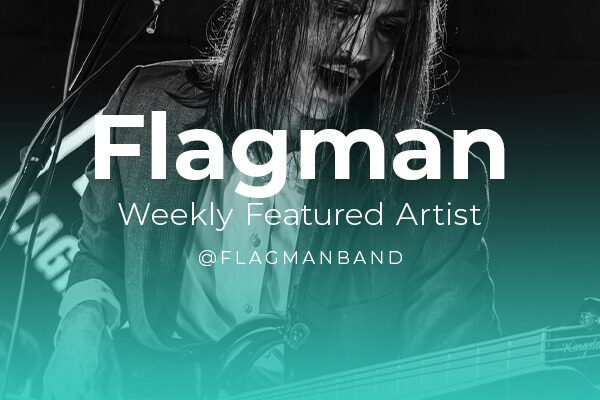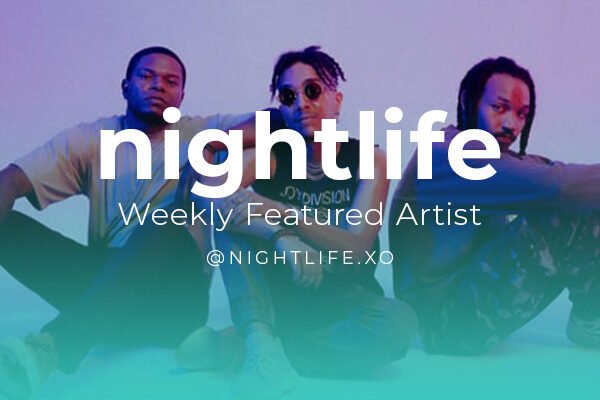Rarely does an artist just pop up out of nowhere and change your perception of certain types of music and their mutual interconnectedness; well, you could say that our latest Weekly Featured Artist did that for me. You see, I was vaguely aware of Danish multi-instrumentalist and composer Zeki Jindyl before taking on a premiere of his single “Wounded” (more on that here), but that was for his contributions to a completely different project. How could I have known that this contributor to one of the best metal records of 2024 would turn out to be a genre-bending mastermind in his own right?
Be that as it may, I’m very glad I took that plunge, because not only did “Wounded” make for some spectacular listens, but its parent album Stretch//Relations absolutely stretched the relations the styles he touched on had in my mind. Jindyl draws from a borderline ridiculously well-articulated palette of sounds that ranges from post-metal and abstract experimentalism to Middle Eastern folk music and even alternative r’n’b stylings. And the craziest thing is, the resulting music doesn’t sound even a bit pompous, disjointed, or self-indulgent, which is more than a lot of artist can say about themselves when trying to bridge the gap between disparate musics.
Of course I had to ask Jindyl whether or not he sought out that broad set of influences on purpose, or if this approach just came to him naturally. Turns out it was a bit of both, as Jindyl elucidates:
‘I have had a forced relationship with influences in the past, where I tried too hard to implement styles that were so far beyond anything I could do naturally, that it would take years to master, which always led to a less than satisfying result – I learned a lot, but with Stretch//Relations it was kind of a epiphany: why not just write what comes naturally and let the music inform me of my influences, and then use that deliberately as a tool for refinement? I’ve always struggled to finish music and find out what I wanted to do as an artist, but this mindset of just writing a bunch of stuff and letting that uncover my style instead of me intellectualising it and forcing a process has been really liberating.‘
I relate to that sentiment a lot; when I was first getting heavily into music, I voraciously jumped anywhere my whims would take me, absorbing lists and articles and whatever else would bring me closer to a deeper understanding, without considering a more personal and natural interaction with the music I sought out. Seeing that an outstanding artist such as Jindyl had similar struggles is a relief, because it shows me that those moments weren’t spent in vain; if anything, they were a lesson in what not to do, and a signpost for future reference.
Anyway, these days Jindyl tries to engage with music organically, turning the act of discovery into a hobby more than anything. With the help of ‘Instagram curators‘ and the guidance of live performances, he seeks out music that catches his ears; but it’s his friends who recommend ‘70% of the music I hear.‘
Whenever I do an article like this, I try and ask the artist in question what influences they pull from outside of music – I find that side of their interests quite fascinating, personally. As for Jindyl, this is what he had to say:
‘I actually don’t remember the name of the painter, but i was given an exercise by my friend Jaleh Negari and it’s inspired by a painter, where you paint the same picture 50 times, and you are not allowed to think or be critical about them, and you have to do it fast, so you don’t judge and your intuition takes over. I used this process for soundscaping and learning some specific tools in ableton for Stretch//Relations, and through that process you find a workflow, style, and tools you like combined with a ton of material you can pick and choose from.
‘I am an overthinker, and feel like many musicians are, so it’s easy to get caught in your own head – exercises like this have really helped me generate material and uncover my style.‘
Everything Is Noise: Is there an overarching theme to Stretch//Relations, like a thematic or emotional throughline?
Zeki Jindyl: Loosely yes. Stretch refers to the music primarily. I try to stretch the music both in time (most of the music is without a steady pulse), so the music is driven forward by phrasing, instrumental or vocal cues, and in ‘fabric’ – what makes this part sound like metal, and how far can i stretch it (in instrumentation, production etc.) before it stops being metal and starts to be something else? Relations is referring to the lyrical material – most of the lyrics revolve around some kind of relationship.
EIN: Where did the album title come from?
ZJ: It comes from what i described above – it stuck. I tried to change it a couple of times, but it was impossible, so like the rest of the record: it felt natural, so I kept it.
In the press material for Stretch//Relations, one of the key points is that the album is held together by a collage-like approach. This feeds back into the struggles alluded to earlier, with Jindyl disclosing that: ‘I have a hard time writing conventional song forms, and i like a lot of different music, so the thought process has been – what kind of overlaps are there in these genres and this music i make? Is it possible to stitch them together? And that has been a very fun creative process to make collages and stitching together different genres and forms in a way that i found pleasing.‘
He went on to add that ‘some [of the aforementioned collages] have come natural, others I had to think a lot and come up with either harmonic ways to do it, but it could also be done through sound design, where you can smear the harmonic material so it gets less obvious.‘ This explains a lot about the far-reaching yet harmonious aesthetic of Stretch//Relations, and gives you a good glimpse at the process that went into making this outstanding piece work as a cohesive whole.
Here’s where I would like to circle back to the premiere I mentioned in the beginning of this article; after all, this whole thing wouldn’t have happened if I hadn’t taken on the task of writing about “Wounded”. It’s a song Jindyl wrote, performed, and recorded entirely on his own, using his voice and EWI to create a stunningly unique track. I had to ask Jindyl about the decision-making behind this track, and how it felt to be completely on his own for it. This is what he had to say:
‘A lot of the album has been created in my home studio in front of a computer where everything is possible, and you can take endless takes of all your parts, which is incredible but also overwhelming and it’s easy to lose track of the initial idea, its purpose, and also when to stop. I decided on it because I had to shoot a live session of 2 songs from the album and Kristian Foldager and Mathias Døcker who filmed and directed the live session asked me if I could perform anything solo, because they thought that would work well with the setting.
‘I had tried to write for EWI and voice in the past, but I didn’t really like the result, but the deadline for the live session and the restrictions of the setup really got something special out of me. Initially the song was only meant as a singular performance piece for the session, but the result was too good so it had to make the record. It’s the closing track and i think it is very fitting – after all, the exploration through the record I return to my ‘horn’ and voice – my strong suits and longest companions in my musical life.‘
EIN: You use electronic wind instruments quite extensively, which is a rare sight. When and where did you first come into contact with this kind of instrument, and what drove you to use it on your recordings?
ZJ: I first tried one back in 2015 or something and thought it sucked (I didn’t know how to calibrate it, and the internal sounds wasn’t good), then i saw a lot of Youtube videos with Michael Brecker and also Massato Honda of T-Square, and they are master saxophone players and incredible EWI players. I searched for other wind instrument players, and most were devoted to the fusion and ’80s aesthetic. The EWI also has a kind of bad reputation as a corny instrument, so as a contrarian I wanted to see if I could use it in a more contemporary way, and when i got my hands on a EWI 4000s back in 2020 I was in love – I think it is a very misunderstood instrument – and underutilized. It has so much flexibility and you have the expression of a hornplayer with the sounds of a synth – it’s also an incredible tool for synths that support breath control. I am working on implementing that in the future.
EIN: What’s your favorite piece of gear (instruments, effects, etc.) you used on your new album?
ZJ: Honestly, it’s been the Archetype Plini amp sim – it has been a great tool to make music in the afterhours – and it sounds great on EWI and Saxophone, too.
Looping back once again to the connection to AERKENBRAND that initially led me towards Jindyl’s own output, I wanted to know how their collaboration came to be. Turns out the roots went far deeper than I had anticipated:
‘We are very good friends. We have known each other for almost 20 years, and when their new music started to take form with the arpeggio guitar and a more dreamy and ambient aesthetic they thought it would make sense to bring me along. We are a part of the same friend group which have had a lot of overlapping projects, bands, and we still use each other – Antonius is going to feature on the next Narcosatanicos album, so we still use each other creatively and it’s actually really beautiful and wholesome to share and create with good friends even after all these years.‘
It’s a beautiful thing to have friends who share your vision and can help you present the best version of yourself as an artist, so reading that Jindyl and the AERKENBRAND guys go way back was a delight.
Moving on, Jindyl has set clear goals for himself and his music. While acknowledging the financial and logistical strains it would bring, he hopes to tour with a whole band in the future, having done his share of stripped-down solo performances in the past; on one of those occasions, he premiered Stretch//Relations in its entirety. Aside from the road life, he is also working to put together a collaborative EP with musicians from his home scene in Copenhagen.
You can follow Zeki Jindyl on Facebook and Instagram; his music is on Bandcamp if the above enticed you into checking it for yourself. To close out this article, I asked Jindyl to address the Everything Is Noise readership directly – these are the words he chose just for you:
‘First of all, thank you for reading all this, and remember to let your work inform you of who you are, and not the other way around! Do more, think less! The answers lie in the work! You can do it, and I hope you have a great day.‘






